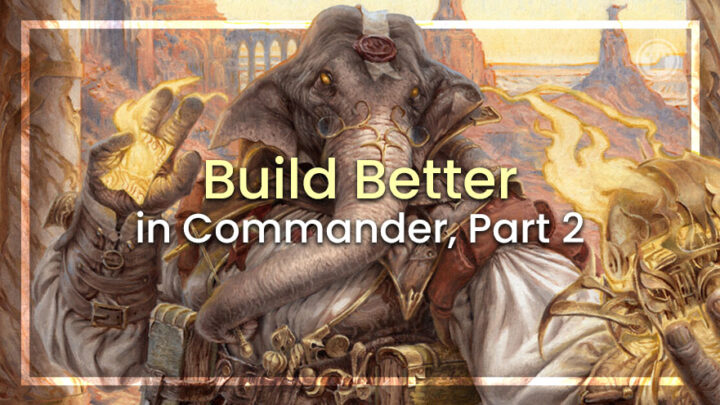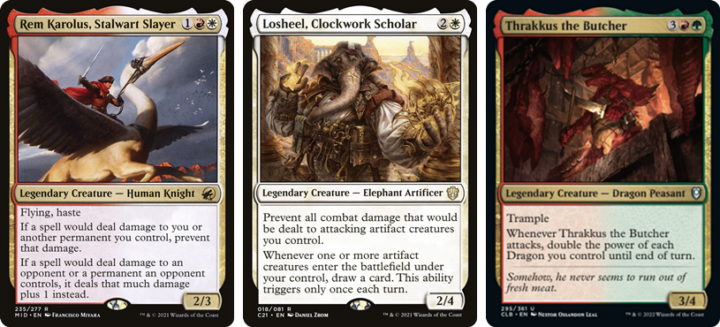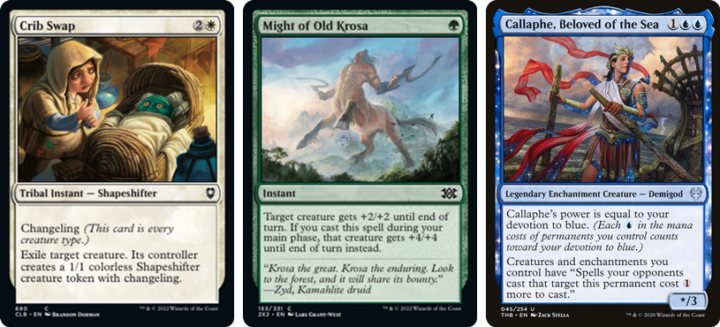Everyone wants to feel unique when playing Commander. Building a Commander deck that is unlike any other lets you stand by your creation with pride.
However, this can be quite difficult given the sheer volume of players and decks out there. To give some perspective, EDHREC alone has data on over a million decks — so finding a unique take on a build can feel like an impossible task.
Thankfully, it’s not actually that difficult to make a distinct new deck, if you know what to do. We went over a few tips and ideas already, but there’s still more you can do. From pre-build research on commanders and archetypes to more deck specific adjustments, by following these steps, you’ll find your next, wild brew in no time.
Choose an obscure commander
The commander is often the most characterizing card in your deck, so a great way to start a unique build is to choose an obscure commander. Generally speaking, nearly all legendary creatures make for excellent commanders, and the lesser known ones are no exception. They are usually unpopular because they weren’t an obviously powerful choice when they were first released. That just means there’s a treasure trove of potential waiting to be discovered.
If you want to browse through obscure commanders, go to EDHREC and choose the color(s) you want to play with. Then just scroll down until you see commanders with fewer than a thousand decks to their name. This is where you will find commanders that you may have never even seen before, let alone considered building.
Take Rem Karolus, Stalwart Slayer for example: they have only 574 decks to their name, so chances are you haven’t played with or against them yet. Their abilities are familiar for their colors while still unique to them. They would make for a fantastic Burn deck that would feel different when compared to other, more popular choices like Torbran, Thane of Red Fell (3409 decks).
Losheel, Clockwork Scholar (327 decks) is another hidden gem. They’re a phenomenal choice as an aggressive yet grindy artifacts commander, and they’ll feel entirely different to the likes of Osgir, the Reconstructor (5547 decks).
Perhaps, most shockingly, Thrakkus the Butcher has just 93 decks to their name. They are a criminally overlooked dragons commander, likely due to Miirym, Sentinel Wyrm’s release in the same set (4616 decks). They may not copy dragons, but doubling their power makes them one of the best choices for an aggro commander.
These exceptional commanders are out there. You just need to do a little digging to find the diamonds in the rough.
Play outside the typical colors
Some folks like to decide on a playstyle they want to follow first, and finding a distinctive angle to an archetype can be tricky. One great way to uncover a fresh approach to a playstyle is to find a facilitating commander outside of the archetype’s typical colors.
The easiest way to find these commanders is to find a theme that speaks to you, go to its theme page on EDHREC and look toward the bottom of the top commanders section for anything that catches your eye. If there’s nothing exciting there, or if you want to look deeper, you can choose a color combination at the top of the page and see what other commanders show up. You’ll be surprised what you might find!
Here are a couple of examples that might spark some inspiration. First, most sacrifice decks primarily use black, which makes Yedora, Grave Gardener a strange and novel choice. Mono green sacrifice can’t rely on most of the typical enablers and payoffs, so some creativity will yield a truly unique build.
Meanwhile, +1/+1 counters decks are typically green or green-white based, so picking Fain the Broker as your counters commander would show a quirky take on the archetype.
Finally, almost all spell copy decks have red as the primary color. This is why Errant, Street Artist would helm a truly bizarre version of a spell copy deck, eschewing the very color that forms the foundation of the play style.
Each of these examples will have a lot more replayability than most decks in their respective archetypes, too, as they’ll be full of underexplored cards and lines of play.
Play with ‘bad’ cards
There are thousands of cards that don’t see play in Commander, despite many of them being quite powerful. This is usually down to staples taking their place when building decks, which can make them look like worse choices.
However, if you want to make a truly unique build, try and resist the urge to add your Swords to Plowshares or Cyclonic Rifts. Instead, do a little bit of research on Scryfall or EDHREC for alternatives that may fit your new brew better.
I mentioned Alesha, Who Smiles at Death in last week’s article as being a great niche choice for a goblins commander. Rather than adding Swords to Plowshares to that deck, you could try Crib Swap instead — which you can tutor for with Goblin Matron or Boggart Harbinger. Plus, it’s made cheaper with Goblin Warchief and you can recur it with Wort, Boggart Auntie.
You tend to miss out on these synergies with the most efficient staples, which may lead to your deck feeling like it’s missing something. I recently talked at length about replacing staples on The BM Cast, if you’d like some extra resources on this topic.
You can also try building around what are generally considered to be “bad” cards. A great example is my Gale, Waterdeep Prodigy/ Raised by Giants deck, where I look to use instant and sorcery pump spells to gain value and take out opponents.
These kinds of spells tend to see very little play in Commander, as they don’t usually scale well to multiplayer formats. I decided to set myself the challenge of building a deck that can maximize their impact and effect. The result was a deck that always excites any table I play it at.
Another example of building with “bad cards” is my Callaphe, Beloved of the Sea deck. It’s a mono blue aura voltron deck, which is also strange enough to be considered outside its archetypal colors, similar to my previous point above.
Most blue auras rarely see play, as they’re often outclassed by their more potent green or white counterparts. Callaphe enhances their impact by growing in power with each additional blue pip they provide while making them harder to remove.
I also decided on a sea creatures subtheme to keep the deck feeling more thematic overall. Octopus and Leviathan aren’t heavily played creature types either, so they’re usually a welcome change when they hit the table. The deck is now a favorite of mine that never fails to impress, and always entertains.
Restrictions breed creativity
If you ever find it difficult to get creative with a brew, try imposing a restriction on the project.
When you prevent yourself from traveling the usual path in your deck building process, chances are you’ll arrive at a totally new destination. These restrictions are often utilized by the best Commander deck builders, and they will work for anyone that wants to shake up their brews.
One of my favorite restrictions is the “gumball” restriction. The idea is simple: choose any commander you like, then you must build a deck only using cards that cost 25 cents or less. This is a pretty extreme restriction as it prevents you from using the most popular cards in Commander, but that means you get to find awesome new options for each card slot.
Perhaps my favorite gumball deck is Lenny Wooley’s Urza, Lord High Artificer deck. When I first played against it, I saw Urza in the command zone and grew concerned — Urza is an infamously powerful commander, after all.
Lenny assured me it was an Urza deck like you’ve never seen, and boy was he right. There was no Isochron Scepter or Sensei’s Divining Top, with Nephalia Smuggler and Sunset Pyramid in their place.
It was a joy to behold. He shattered my expectations and showed the table that with some heavy restrictions, even the most salt-inducing commanders can be built for a good time. In fact, it was so inspiring that I tried my hand at a Hinata, Dawn-Crowned gumball deck.
Hinata is known for being absurdly powerful when built typically, but when you’re limited to cards that cost a quarter or less, the experience they provide changes dramatically. This is obviously great for limiting the power of a deck, too, and it might let you play a powerful commander in a more enjoyable way for casual games.
Another effective restriction can be to build an Artisan Commander deck. Artisan Commander is an increasingly popular subset of Commander that uses only commons and uncommons — and placing this limit on your brewing in this way can really inspire some creative builds.
Here’s my Syr Carah, the Bold Artisan deck: a Burn/Storm deck that looks to use Syr Carah’s ability to the fullest. This deck is all still 100% Commander legal, but it’s built completely differently than other Syr Carah builds due to the limitations. The result is a much more temperate build that could play nicely with recent pre-cons and lower power decks, while also being able to hold its own in an Artisan Commander pod.
Cost limits aren’t the only restrictions you can use, so feel free to get creative! You could build a “storm tribal” deck where every card in the 99 must have the word “storm” included in its title, rules text or flavor text, or build with a common theme in the artwork of each card. The only limit to these limits is your imagination.
Use Rule Zero in deck building
Finally, if you really want to think outside the box, you can take advantage of the most unique aspect of Commander: Rule Zero. Experimentation and self-expression are core tenets of Commander, and the Commander Rules Committee recommends Rule Zero as a way to customize the game to help facilitate this. It’s how you can use silver bordered cards in the format, or have Norika Yamazaki, the Poet and Heiko Yamazaki, the General as partners.
You can use Rule Zero to bend and change the rules of the game to make some really exciting and unique brews. As long as you have the appropriate conversation before the game so that all participants are on the same page, then anything goes.
If you’re building a white deck, why not put four Squadron Hawks in a deck? You could try to build a deck with a planeswalker or even a non-legendary creature as your commander. If you fancy yourself as a bit of a designer, you can even make up a totally new card and build around that. Your options are only limited by your desire to experiment.
I will recommend that you prepare alternatives for all the Rule Zero parts in your decks, however. Not everyone will feel like playing with certain changes, and that’s ok.
If you have replacements ready for when this might happen, then you can still play your deck to a functional degree. Alternatively, have a second non-Rule Zero deck ready if possible, so you can ensure you have an enjoyable experience regardless.
End step
There is no real limit to creativity, but sometimes we just need a little nudge to get the juices flowing. If anything in this article has inspired you to start a new brew, I’d love to hear about it. Tag me on Twitter to show me your exciting new creations, and tell me about the restrictions or challenges you set to make them happen.

Scott is an Irish content creator and the Head of Budget Magic for the Izzet League. He focuses on affordable decks in Pioneer, Modern, and Pauper, particularly ones that stray from the mainstream. When he’s not writing about his favorite decks, he can be found talking incessantly about them on Twitter and on The Budget Magic Cast.






